January 24, 2023 feature
Solid Earth-atmosphere interaction forces during the Hunga Tonga-Hunga Ha'apai volcanic eruption

Thamarasee Jeewandara
contributing writer
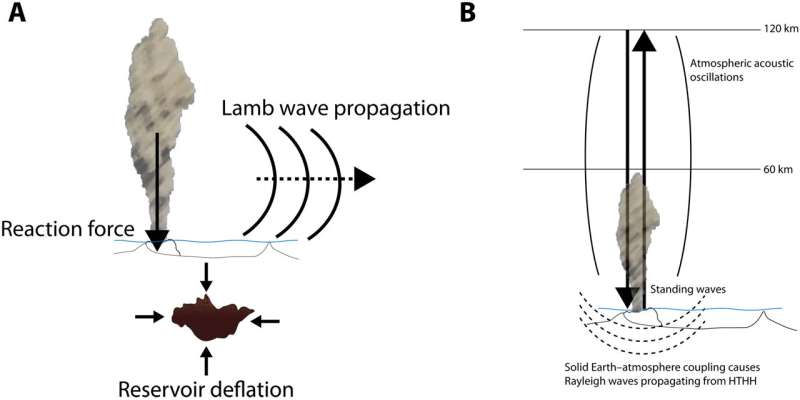
The submarine volcano eruption of Hunga Tonga-Hunga Ha'apai that occurred on January 15, 2022, generated impulsive downward reaction forces on Earth, radiating seismic waves throughout the planet. Geologists analyzed the and Rayleigh waves at approximately 50 seconds to determine the force history and provide insights into the overall volcanic eruption process. The acoustic waves generated during the process produced broadband ground motions across the land alongside conventional tsunami waves.
In a new report now published in Science Advances, Ricardo Garza-GirÏŒn and a research team in Earth and Planetary Sciences at the University of California, Santa Cruz, the Earthquake Science Center California, and the seismological lab at Caltech and the University of Strasbourg, France, described the solid Earth-atmosphere interactions surrounding the process.
The Hunga Tonga–Hunga Ha'apai eruption
The Hunga Tonga–Hunga Ha'apai eruption that occurred on January 15, 2022, produced the highest plume of any prior volcanic eruption—due to the . The event produced a in the middle stratosphere due to the degree of magma-water interactions at the ocean surface, on account of the submarine volcanic eruption.
The process simultaneously produced almost 590,000 lightning strikes observed globally in the ionosphere and atmosphere, partially driven by an and via . The phenomenon was the largest eruption to occur since the 1991 eruption of in the Philippines. In this work, Garza-GirÏŒn and his team presented several seismic methods to quantify and represent the ground mechanisms surrounding the phenomenon.
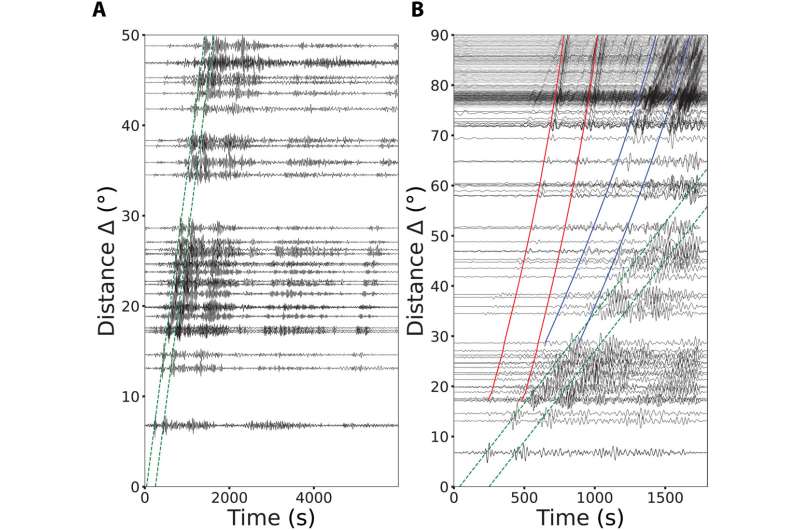
The fundamental forces
Three fundamental forces contribute to the ground motion detected by relative to the 2022 Tonga eruption. These include direct seismic waves resulting from the eruptive process itself and two other interactions associated with atmospheric disturbances relating to the eruption of downward reaction forces and atmospheric acoustic waves, respectively. The downward reaction forces impacting the Earth can act at the source during rapid pressure deflation in the magma reservoir and conduit system to rapidly vent material in the eruption jet.
The process involved a complex combination of force systems that almost coincidentally acted to lower the pressure in the magmatic system to move material to the surface of the volcano and jet it out to the atmosphere. The research team put together a comprehensive, time-varying, analytical characterization process to provide insights into the seismic sources involved at the most energetic stage of the eruption.
-
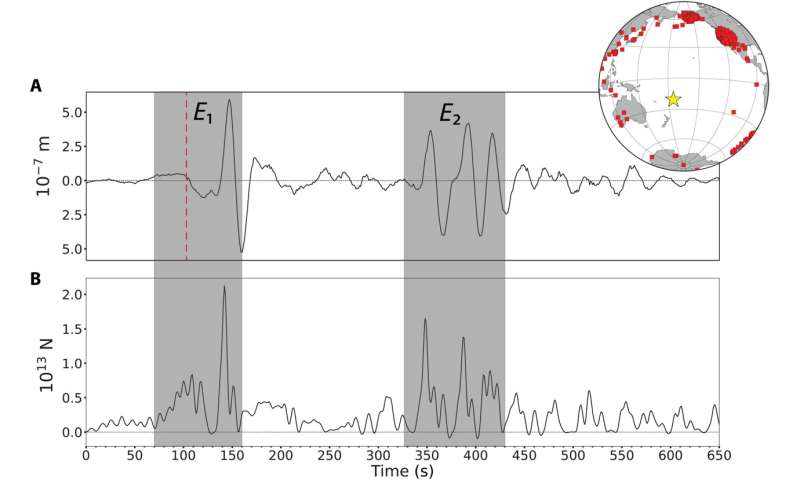
Global P-wave ground motion and reaction force time series. (A) Global stack of 518 vertical component P-wave ground motions from stations shown in the inset map, filtered in the passband of 0.01 to 0.05 Hz and corrected to a reference distance of 78.5°, which is the median distance of all stations used for the body wave analysis. Time is from 100 s before the P-wave arrival time at 78.5° [04:26:46 UTC, red dashed line] relative to the origin time of the M5.8 event (04:14:45 UTC), located by the USGS. Note the smooth low-amplitude long-period energy within 40 s preceding the expected arrival. (B) Vertical downward (reaction) point-force time history obtained by deconvolving the global stack by an impulse response Green's function, with imposed positivity constraint. The first two main volcanic events E1 and E2 are shown in the gray boxes. Credit: Science Advances (2023). DOI: 10.1126/sciadv.add4931 -
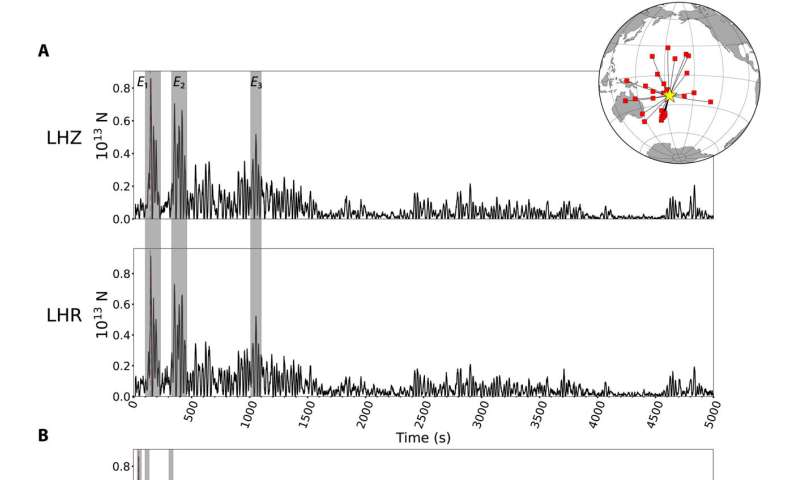
Vertical reaction force time history from Rayleigh waves. The median stack vertical point-force time histories obtained by deconvolving individual displacement recordings extending for 5000 (A) and 16,300 s (B) after the source began by corresponding Green's functions for vertical motion (LHZ) and horizontal motion (LHR) of short-arc Rayleigh waves. The inset map shows locations of the 30 stations used. Consistency of the LHZ and LHR time series confirms that the motions are Rayleigh waves. Intervals of the seismograms when ground motion was contaminated by the passage of the atmospheric Lamb pulse were screened out before stacking the individual force time histories. The first three main volcanic events E1, E2, and E3 are shown in the gray boxes. Credit: Science Advances (2023). DOI: 10.1126/sciadv.add4931
Direct reaction forces and resonant forces
The research team calculated the axisymmetric radiation of body waves and surface waves resulting from the source location to assess the process of rapid vertical venting seen during the explosive eruption. Taken together, the and showed the sequence of explosive eruptions that lasted approximately four and a half hours to generate the reaction forces seen across Earth.
Following these assessments, the researchers noted how the narrow-band long-period ground motions for the 2022 Tonga eruption showed similarities of resonant Rayleigh waves to those seen during the . The oscillatory forces computed at the site of the source showed a large amplification at approximately 4,500 seconds after the event to indicate the time taken for the atmospheric acoustic standing modes to develop.
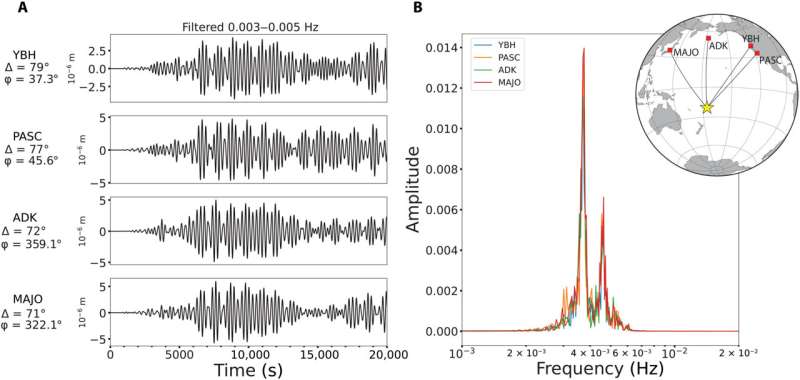
Outlook
In this way, Ricardo Garza-GirÏŒn and colleagues showed the profound implications of the dynamics of rare, very large volcanic eruptions. The observed wave motions resulting from the 2022 Tonga eruption spread across the land, sea and atmosphere. The bursty and energetic eruption process indicated interactions between water and magma, as well as .
The researchers computed the time-integrative cumulative forces acting on Earth during the . The team of scientists further included to describe how further interactions between the land and air could be sustained during volcanic events through atmospheric acoustic oscillations.
Written for you by our author —this article is the result of careful human work. We rely on readers like you to keep independent science journalism alive. If this reporting matters to you, please consider a (especially monthly). You'll get an ad-free account as a thank-you.
More information: Ricardo Garza-Girón et al, Solid Earth–atmosphere interaction forces during the 15 January 2022 Tonga eruption, Science Advances (2023).
Corwin J. Wright et al, Surface-to-space atmospheric waves from Hunga Tonga–Hunga Ha'apai eruption, Nature (2022).
Journal information: Science Advances , Nature
© 2023 Science X Network




















